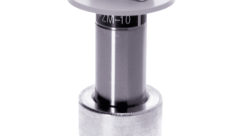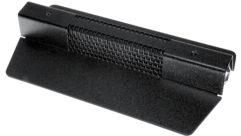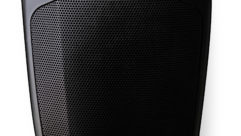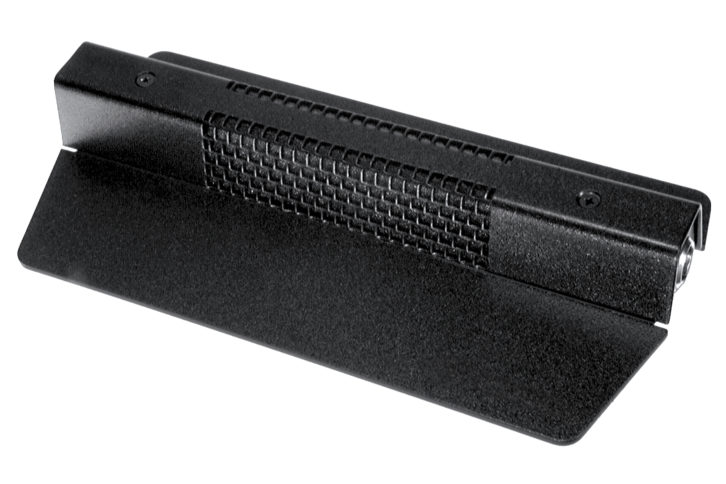
It’s all about backstage functionality and unobtrusive performance. Boundary mics can blend into a conference room’s furniture and barely be noticed while delivering speech similar to that of a gooseneck or headset model without any of their potential breath popping. Combining wireless signal conveyance has allowed these mics to keep their low profile and add mobility while the built-in mics can hide their wiring completely. The story of automatic mic mixing is an amazing tale that started with Dan Dugan’s first model and now that capability, infinitely refined, has been incorporated into a vast array of products across the AV industry. The devices covered here illustrate the rise and position of these two remarkable tools.

The unique shape and design of the AKG PCC160 boundary mic makes it equally as useful on a stage floor as on a conference room table. Its bass tilt switch can be used to tailor bass response for either application. While its PCC (Phase Coherent Cardioid) technology eliminates phase interference, the supercardioid polar pattern provides excellent gain before feedback and minimizes any background noise. The overall frequency response is 50Hz-18kHz and the signal to noise ratio is 72dB-A. The PCC160 is a wired mic that employs a Switchcraft TA3F connector on the mic body and its black finish blends perfectly with any room décor. The unit operates on phantom power from 12 to 48VDC and is encased in a heavy gauge all steel body.

AKG’s professional digital automatic microphone mixer, the DMM8 U, is a 1RU unit with 6 analog inputs and a stereo input. There are stereo line and record outputs on the rear panel. Multiple mixers can be cascaded to provide up to 80 total inputs. The mixer includes compression, delay, EQ and priority settings along with a headphone output with separate level control.
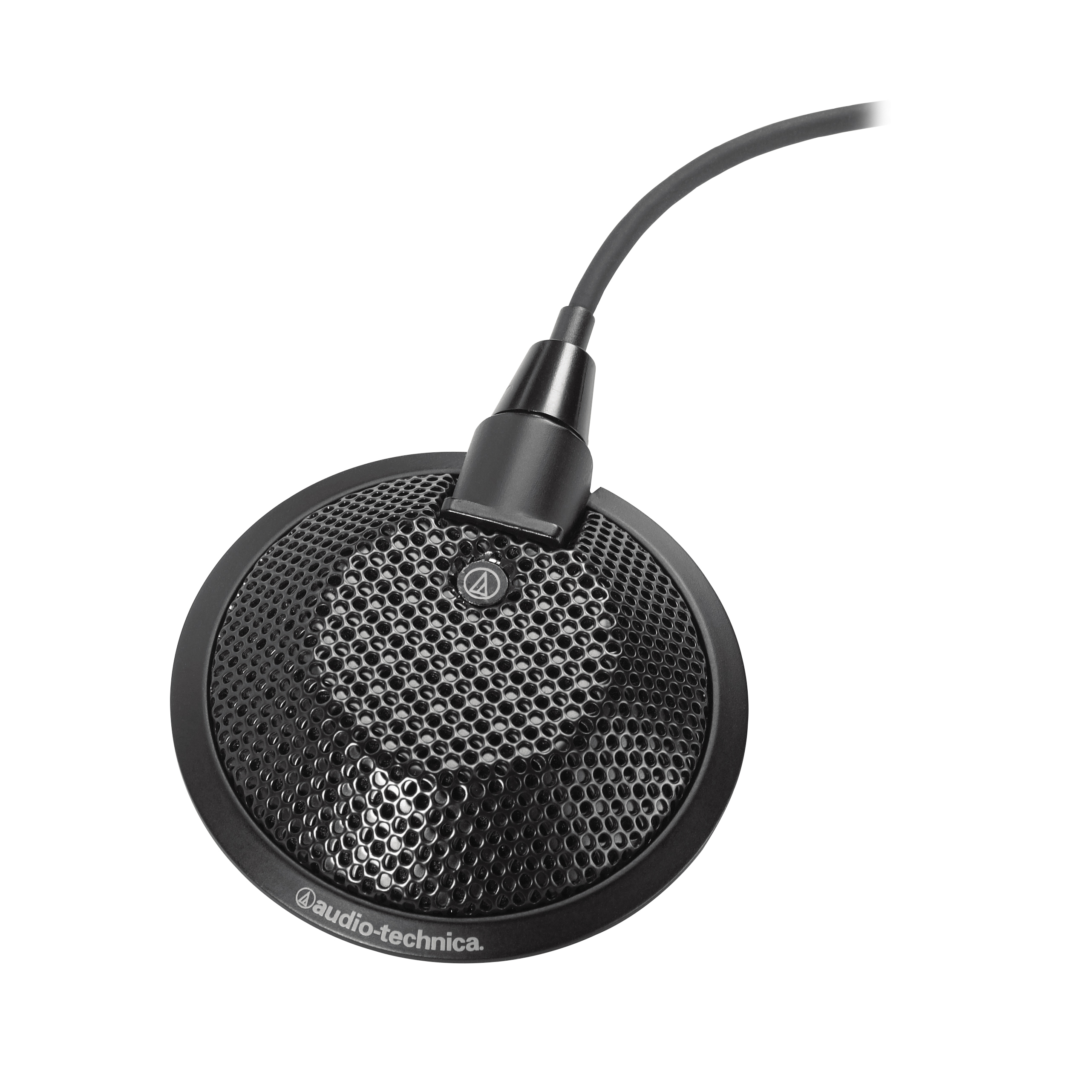
At InfoComm 2017 Audio-Technica introduced the U841A ominidirectional condenser boundary microphone with its small pickup capsule near the boundary to eliminate phase distortion. The mic’s UniGuard RFI-shielding technology provides superior rejection of radio frequency interference (RFI) and its heavy die-cast case and non-slip silicon foam bottom pads minimize coupling of surface vibration to the microphone. The mic system has a frequency response of 30HZ-20kHz and the low frequency roll-off provides attenuation of 18dB per octave starting at 80Hz.
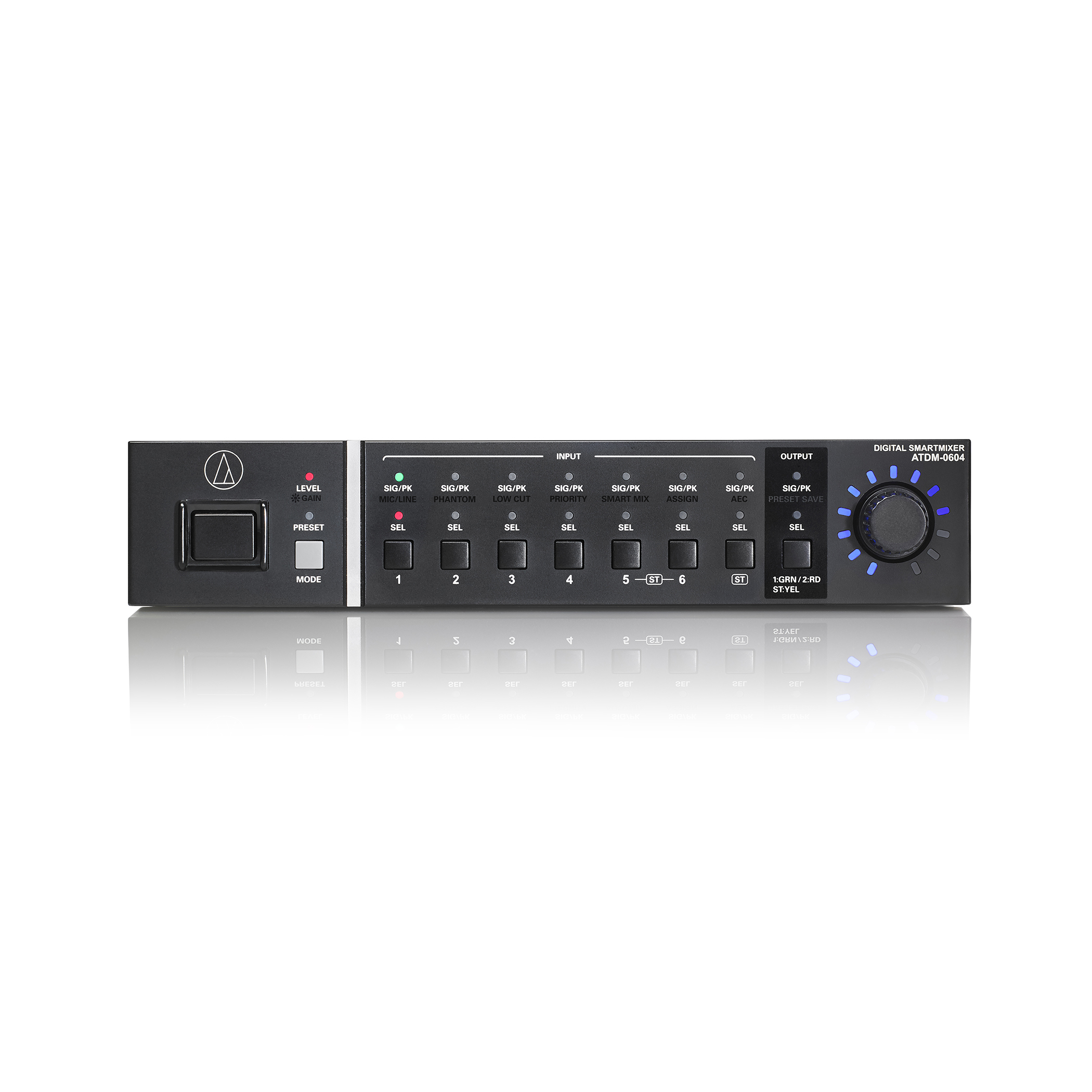
Their ATDM-0604 Digital Smartmixer can control its four balanced microphone inputs, two balanced mic/line inputs and one unbalanced stereo input in either gate or gain sharing mode. Users can set and recall presets, turn on/ off phantom power, low-cut filter, automatic mixing and acoustic echo cancellation (AEC), change IP configuration (Auto or Static), all on the front panel controls. Also featured are two balanced and two unbalanced outputs, network and USB ports.

Audix has designed the ADX60 pre-polarized condenser microphone to pick up high fidelity sound at a distance sufficient for it to be used for conferences, stage plays and even broadcast applications. When connected via its 25ft. cable (supplied) and using the 9-25VDC phantom power adapter, the unit exhibits a hemicardioid polar pattern. Optional accessories include the APS911 battery operated phantom power adapter with onoff switch and bass roll-off. The case is very compact with a 12 mm capsule, black e-coat finish, laser etched model and serial number, steel mesh grill, space saving mini-XLR connector and vibration absorbing rubber base.
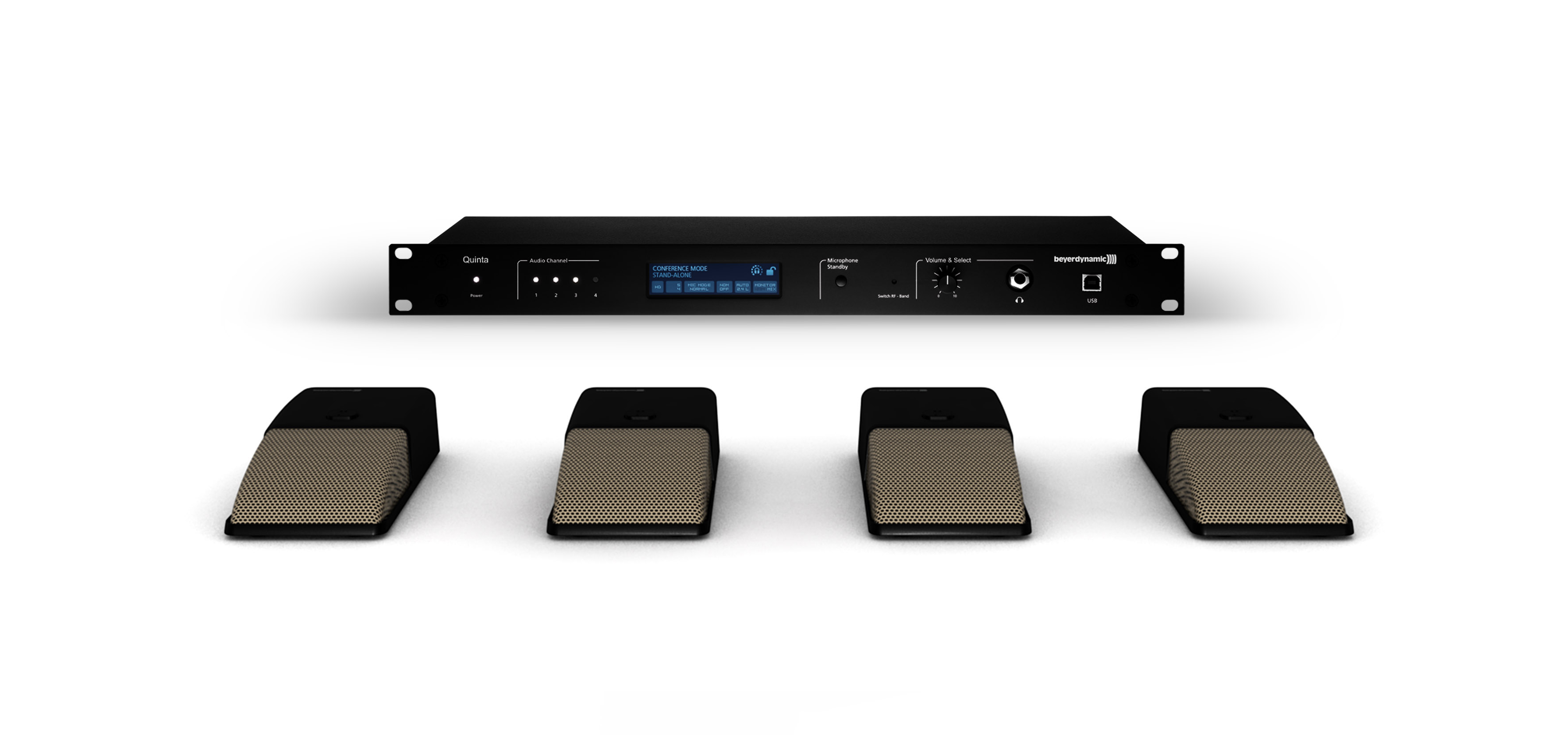
The Quinta TB wireless boundary microphones work with the Quinta RS central control unit in a group of four microphones in mic mode and up to 20 microphones in conference mode. The mics use Direct Sequence Spread Spectrum (DSSS) transmission with integrated True Diversity antenna technology on three selectable frequency bands: 2.4, 5.2 and 5.8 GHz. When the control unit is off or in standby the Quinta TB microphones automatically power off. The mics run on integrated NiMH batteries and charging status of the battery can be monitored and transmitted to the control unit. 128- bit encryption and a 24-bit PIN-code are also used for security and on the front panel there are active channel and power indicators along with a USB port and mic standby button.

For permanent mounting conference mic applications the 220VP continuously variable polar pattern condenser boundary microphone from CAD Audio can be perfectly adjusted for the specific room acoustics in which it is to operate. The body mounts into a 15/16in. hole to provide a very low profile protrusion of the pickup end and a rotary dial allows one of several polar patterns to be selected. The mounting surface can be up to 3in. thick. A high pass filter improves low frequency thump and room rumble rejection while the shock absorbing polymer bushings shield against mechanical vibration. To stay concealed, the 3-pin XLRM-type audio connector is recessed in the body of the microphone and the mic is available in either black or white finish.
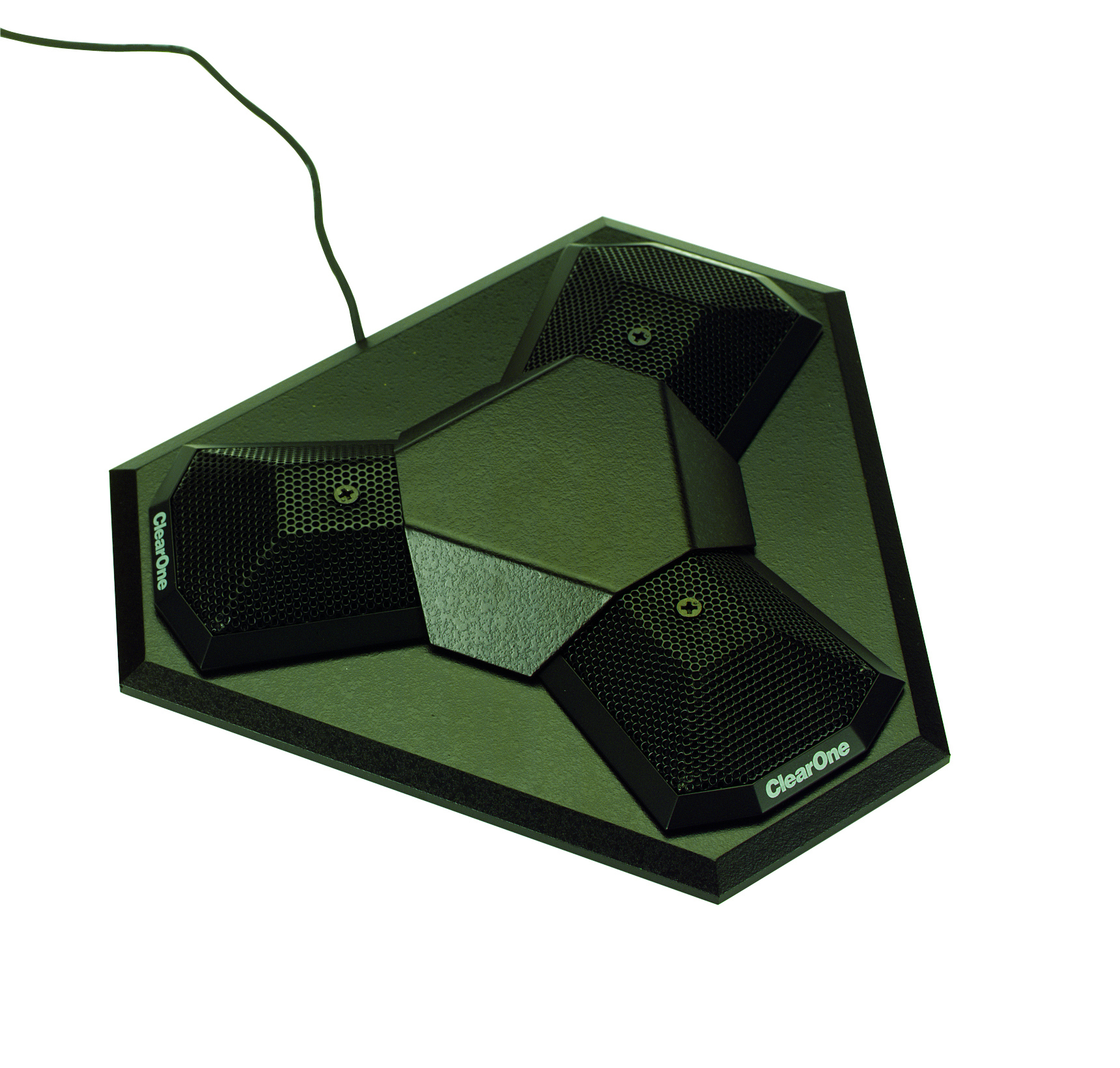
ClearOne designed the Delta Mic to house three unidirectional microphones in a compact form factor case that aims them in a 360-degree pattern and keeps their off axis side upward to reject room noise. The unit requires 5-52VDC phantom power and provides 30Hz to 20kHz frequency response.
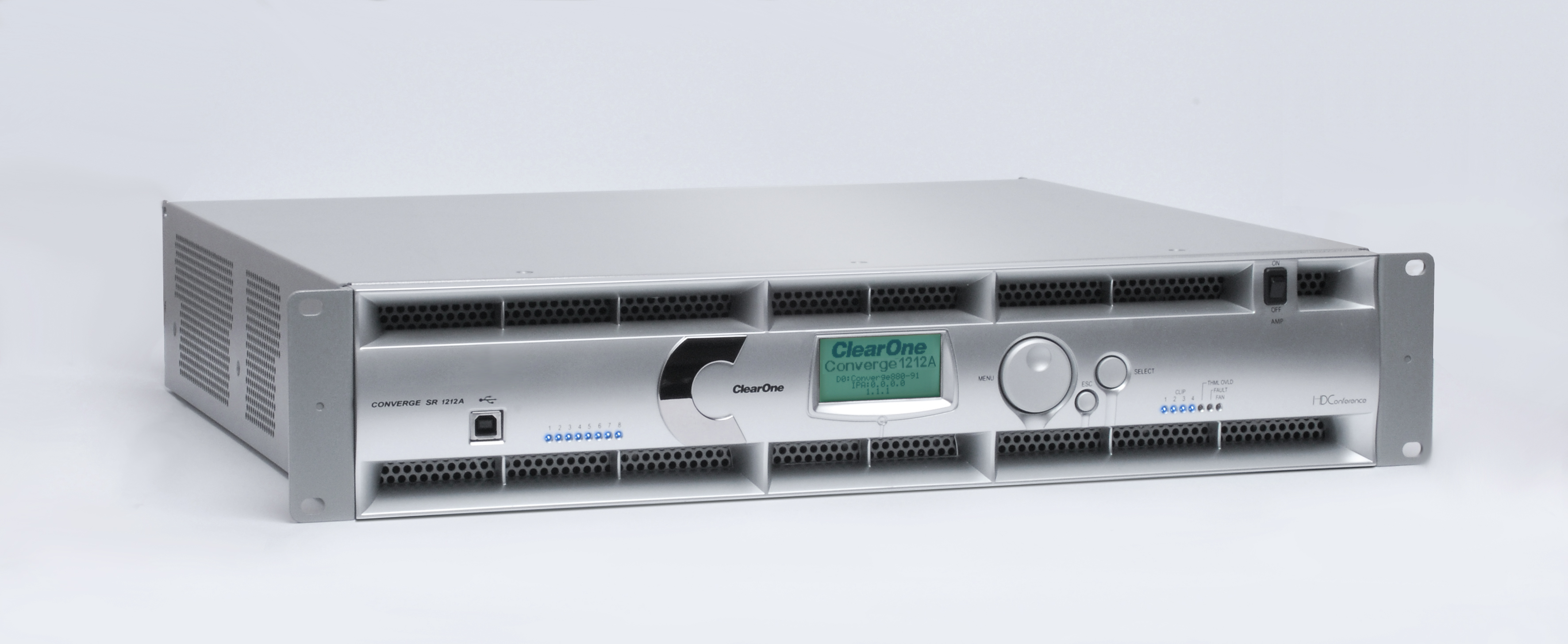
On the mixer front, ClearOne has scored a sustained hit with their CONVERGE SR1212A professional conferencing digital matrix mixer. The system combines automatic microphone mixing with a built-in four-channel power amp while D.A.R.E (Dynamic Automatic Resonance Elimination) completely controls feedback. SNMP and HTML remote management provide flexible options for access and control.
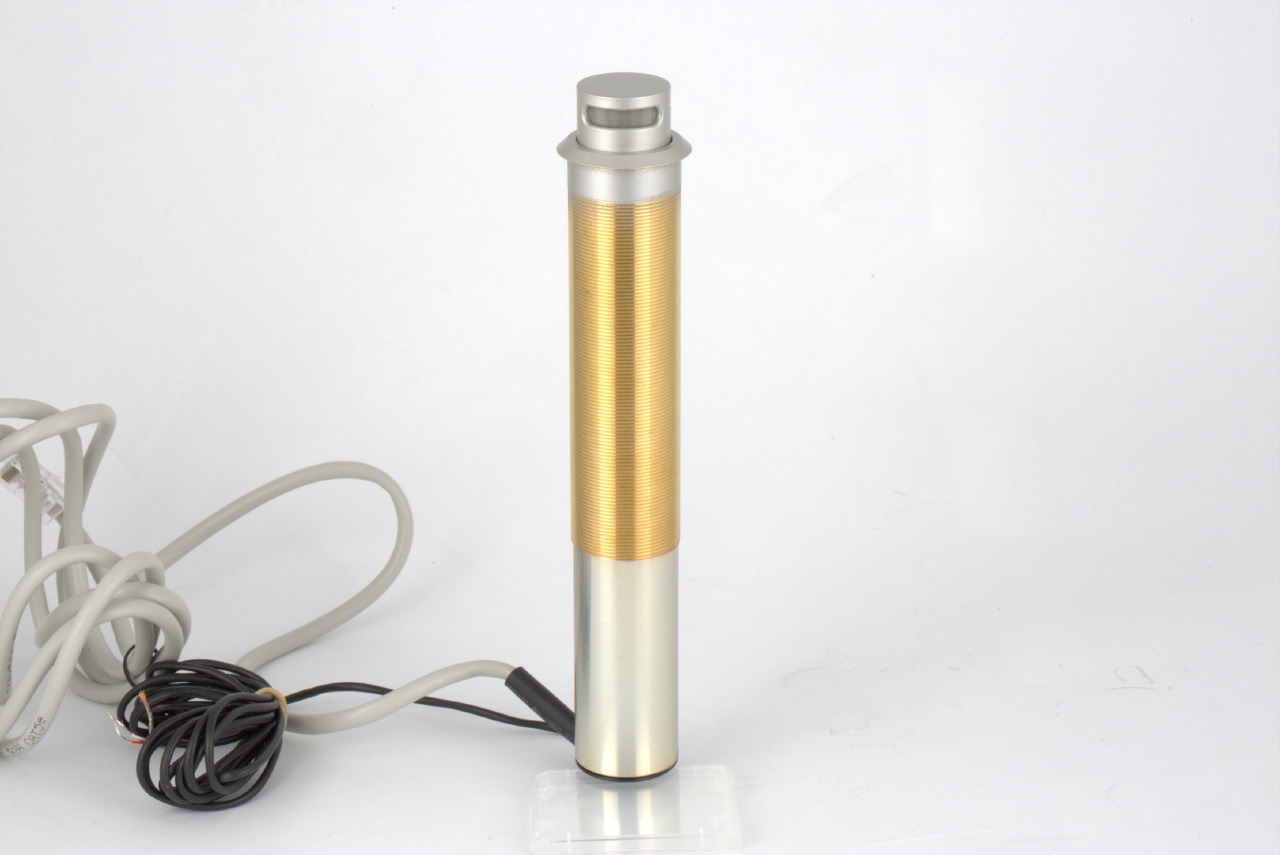
Among the permanent surface mount boundary mic models, the Clockaudio ARM 102-RF Digital Motorized Retracta back electret condenser microphone has a motorized operation that when retracted presents nothing more than a coin sized object on the surface of a conference table. Available in a black or Satin Nickel finish, the unit has a cardioid polar pattern with a 50Hz-18kHz frequency response. Nextel suede coating finishes are available on special order. The condenser mic operates on phantom power from 9 to 48VDC. The integral motor requires the control module ARM-C to operate. A control signal (+2.5V – 12V) from a DSP or Electronic Switch are required to activate the RETRACTA.

The DPA d:sign BLM4060 is a pre-polarized omnidirectional miniature condenser microphone with a 0.2in. vertical diaphragm and the mic body consists of a central rubber disc that holds the mic element mounted in a stainless steel base. Designed primarily for table top use, the unit has a detachable 10ft. cable fitted with a DPA MicroDot connector and a DAD6001 XLR adapter is included. The mic has a 20Hz-20kHz frequency response and a maximum SPL (before clipping) rating of 134dB. The system is optimized for maximum speech intelligibility and its low profile design makes it a good choice for boardrooms, courtrooms and conference facilities.

Automixing pioneer Dan Dugan and his company Dan Dugan Sound Design have introduced their latest product, the Model E-2A, an automatic microphone mixing controller with 12 channels of analog and 16 channels of ADAT processing supporting Dugan’s Speech System, Music System and Gain Limiting algorithms. The channels can be grouped into three independent automixers and a six bus pre/post matrix mixer is included with 56×6 capability. For control, there are six switched Ethernet ports and the OLED front panel enables setup directly from the device. The Model E-2A may be linked with additional E-2A units as well as all other digital Dugan units to control a large number of live microphones.

For temporary or permanent installations, Earthworks has the CTB30 30kHz boundary mic. Available in black, white, silver or Nextel Dark Black finishes, the mic’s Omni Semisphere polar pattern allows very clear speech pickup and its unique filter significantly reduces low frequency table thumping and HVAC noise. The enclosure measures only a 4.1in. diameter to be very unobtrusive at the table. It is equipped with a 10ft. low profile cable with XLR-3M attached and the cable exits from either the side or the bottom of the housing. The XLR connector can be easily removed to pass the cable through tight spaces during installation. The case is RF resistant and its rubber pads eliminate shock and vibration.

Lectrosonics has some infinitely versatile mixers in their ASPEN line and the SPN812 typifies their features with its low noise preamps, Ethernet addressability and automatic slave/master detection. The SPN812 is a single rack space unit with 8 mic/line inputs and 12 outputs. Its Proportional Gain Algorithm provides seamless auto-mixing, integrating easily with echo cancellation, analog mixing consoles, or other sound system. Outputs 1 through 8 are line level while 9-12 are mic/ line. Extensive, simultaneous control can be applied through Ethernet, USB, RS-232 and logic I/O ports using the large command library. All models fully support the 48 outputs provided by the digital matrix and any physical output can deliver the signal from any output in the matrix.

The MXL AC-406 USB Desktop Communicator is a USB table top speakerphone for Web conferencing. The advanced boundary microphone 3-capsule design provides a 180-degree pickup pattern and it can work well with speech-totext software. Compatible with PC and MAC computers, the MXL AC-406 includes a mute switch for private conversations. The enclosure also has a 4-ohm 5W speaker. The upper surface presents a mic mute button/indicator and a power indicator LED. Also on the case are a headphone output, mic extension port and the USB port. These features combine to offer the ultimate in compact functionality and portability.
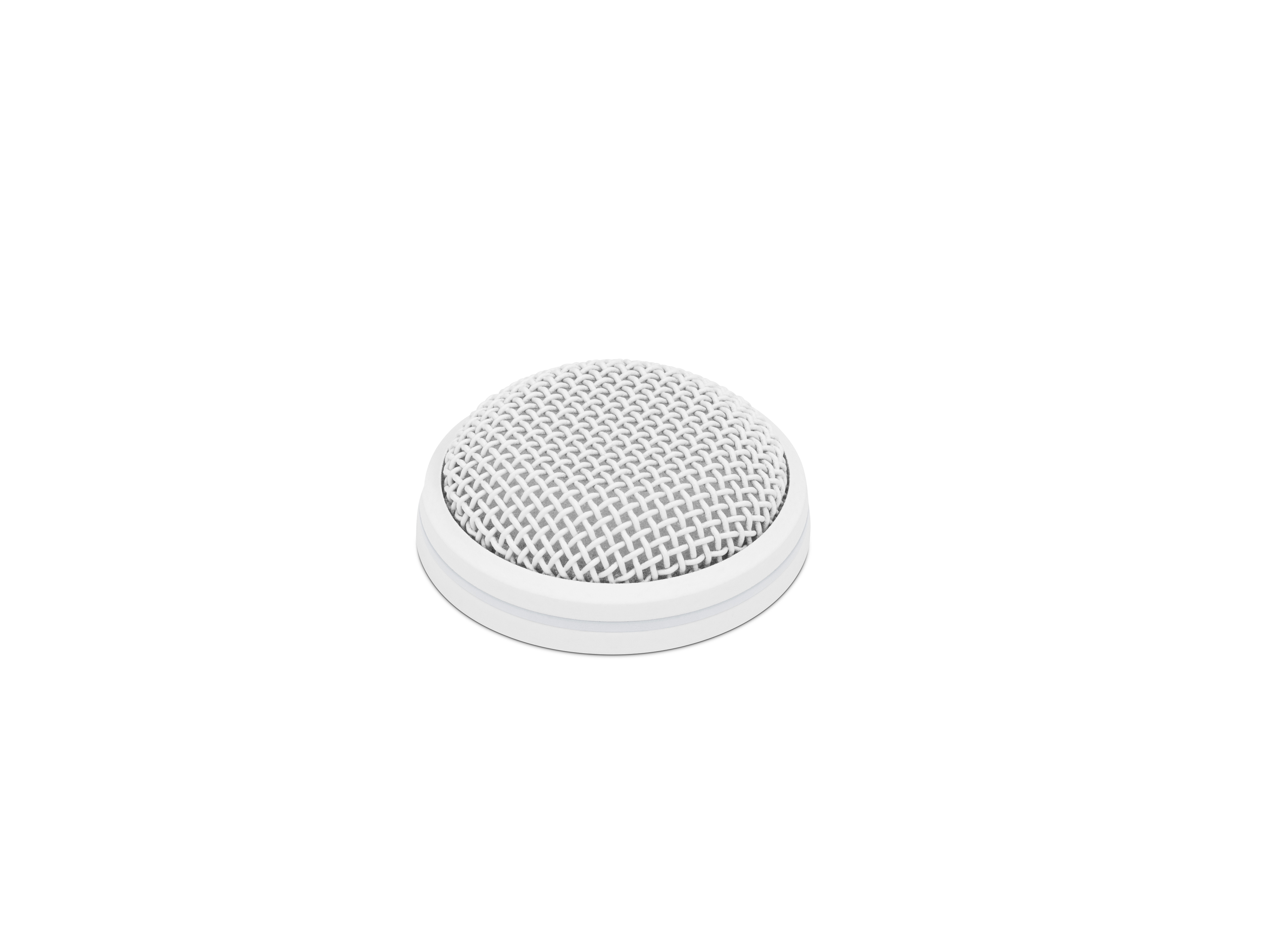
For easy installation into table tops and ceiling tiles Sennheiser devised the MEB 102 omnidirectional cardioid boundary layer microphone. The L variant of this SpeechLine microphone features a bi-color LED ring for status indication along with a 5-pin XLR for light and sound connections. The connectors are mounted inside the bottom of the mic shaft so that the cable can exit under the conference table or above the ceiling tile. The mic has a frequency response of 40Hz to 20kHz and it operates on a 24-48VDC phantom power supply. The case forms an 80 millimeter shaft with M20 x 1.5 thread. Once installed, the mic head protrudes only about 12 millimeters and the unit is available in black or white finish.

The Shure MX690 Microflex wireless boundary microphone can be placed anywhere to use its frequency agile microprocessor controlled transmitter. Its bi-color status indicator is a great feature for conferences and the programmable mute function makes the system adaptable for a variety of specific installation scenarios. The unit operates on two AA batteries. It is compatible with all Shure SLX wireless mic systems and the built-in LCD display includes a battery level indicator.

The SCM820 8-channel IntelliMix automatic mixer is a single rack unit model with front panel level meters, gain and limiter indicators, master level control and headphone jack with independent level control. In addition to the 8 inputs there are aux inputs on the front and back. NAT (Noise Adaptive Threshold) continuously adjusts the activation threshold for opening a channel and Last Mic Lock-On (LMLO) keeps the most recently activated microphone open until another microphone is activated.

The 633 compact six analog input mixer from Sound Devices features 10-track recording capability combined with Dugan and MixAssist automixing to allow it to function as a field recording studio. Recording to SD and CompactFlash memory cards, the 633 provides phantom power, high-pass filter, input limiter and variable pan on each input. There are also 3 line inputs and all inputs are assignable to its six output buses, left/right plus Aux 1/2/3/4. Powered by a unique Quad Power supply with PowerSafe technology, the unit is operational from external DC (12-18 V), two removable 7.2V L-type lithium ion cells, and six internal AA batteries. When one power supply runs down or is cut off, the mixer automatically switches to another. PowerSafe keeps the 633 operating for up to 10 seconds until all file operations are complete before shutdown.

The TOA Electronics EM-700 boundary mic has a cardioid pattern for focused pickup and it features a low-cut filter switch to aid in rejection of background noise. The filter provides a 12 dB per octave cut beginning at 100Hz. The frequency response is 35Hz to 20kHz and the system runs on 9 to 52VDC phantom power. The body is die cast aluminum with black finish and the punched net top cover is steel plate also in a black finish to blend well with any room.
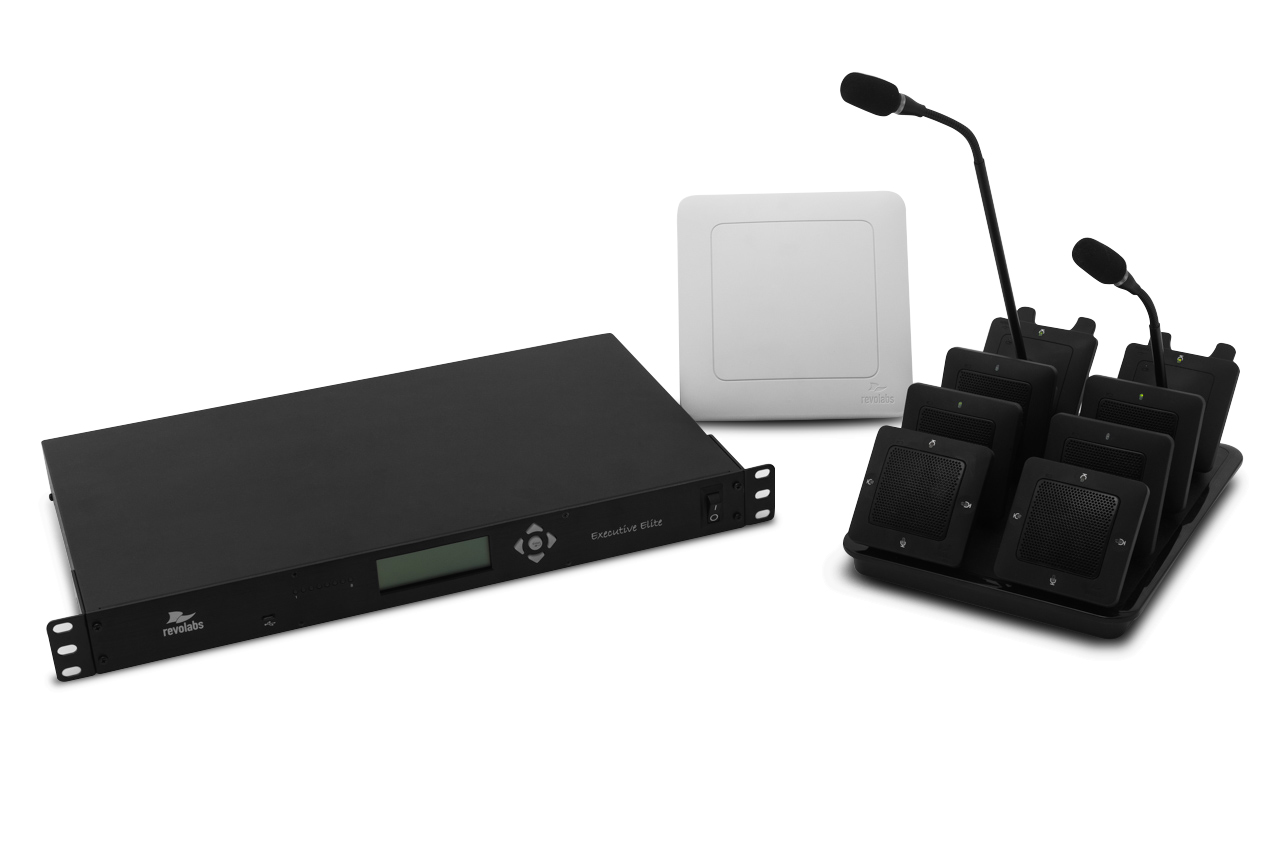
Designed to provide exceptional audio quality in the most demanding environments, high-end boardrooms, large auditoriums and beyond, the Revolabs Executive Elite 2, 4 and 8 channel microphone system, offered now from Yamaha Unified Communications provides the ultimate in configuration flexibility and freedom. As the latest addition to Yamaha’s family of boardroom and conference room solutions, Executive Elite wireless microphone systems are built to handle more. They work by separating the remote antenna receiver from the base digital signal-processing (DSP) unit, creating a distributed architecture that supports up to 44 microphones in one area in the US, South America, and Japan, and up to 76 microphones in Europe, Africa, Asia, and Australia. Plus, they’re designed to provide enhanced integration with room control systems, all while providing users with the freedom of natural movement and the security of 256-bit encryption.


